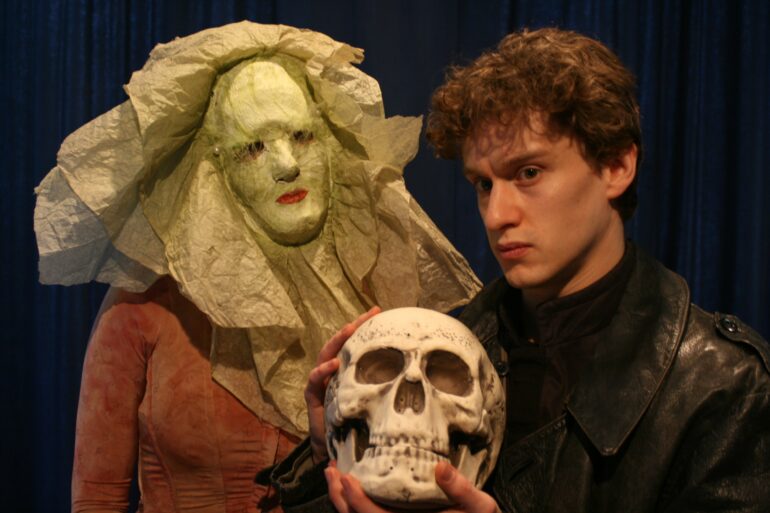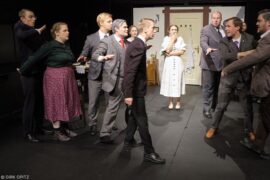The American Drama Group’s production of William Shakespeare’s Hamlet, directed and produced by Paul Stebbings and Grantly Marshall, takes the audience into the world of classical drama, where political intrigue, family conflict, and personal existential questions combine to create a masterpiece of revenge tragedy.
By Sofia Peslis and Anna Savchuk
Picture: Paul Stebbings
On the 7th of February, the Deutsches Theater played host to the American Drama Group’s performance of William Shakespeare’s Hamlet. Founded in Munich in 1978 by Grantly Marshall, the group was linked in the beginning to the University of Munich, where its first performances took place. With actors from New York, London and Paris, the ensemble presents a repertoire of classic and contemporary drama from America, Britain and France.
Fusion of Music and Stage
The way music is used in the American Drama Group’s production of Hamlet is the first striking element. It creates a distinct, enigmatic mood that transports the viewers back to the late medieval times. Changing tones from quiet, nostalgic and soothing to extremely deafening, thunderous and raging, the music, by Thomas Johnson, is an essential component of the drama since it intensifies the onstage events and the emotions they evoke, making the play even more compelling. Performers expertly use their voices to give the play intensity and depth while also playing the selected musical instruments, mainly congas, acoustic guitars, gongs, and drum brushes. Also, different musical elements are added for every character to give them individuality and authenticity. The ghosts’ appearances are always followed by particular unsettling tones and sounds that evoke unease and fear of the unknown. What is more, the actors imitate the sounds of nature, which are well integrated into the background of the play.
In addition, the stage arrangement for the performance is notably unique, featuring an oval stage on stage where actors consistently perform, maintaining a minimalistic static setup without many stage props throughout the play. Despite this, the production achieves a remarkable sense of versatility primarily through the clever use of light effects. The unchanging stage design becomes a canvas for dynamic storytelling, transforming atmospheres seamlessly. Similarly, the challenge of having only seven actors portraying various roles is met with ingenuity. Through clever costume changes and strategic alterations in the play’s narrative, the actors skillfully transition between characters. Ophelia’s assertive refusal in the pivotal scene, where she denies Hamlet the traditional gesture of laying his head in her lap and instead pushes him away, not only enhances her character’s strength but also serves as a clever theatrical device, affording her the freedom to leave the stage and seamlessly transition into other roles, showcasing the production’s resourceful approach to character dynamics. This creative adaptation showcases the production’s ability to maximize the potential of a static stage and a compact cast. Further, through small, humorous interactions with the audience, like throwing pieces of clothes from the stage or showing people in the front row what book Hamlet is reading the production creates an engaging and inclusive atmosphere, adding a delightful touch to the theatrical experience.
Redefining Ophelia
Particular attention should be paid to Ophelia, as she differs slightly from the original play. The American Drama Group brings humor and energy to Hamlet’s love interest by making her dynamic and sympathetic. The actress, Emma Nihill-Alcorta, gives Ophelia a unique personality and is not afraid to look amusing while interacting with other characters and bringing joy to the stage. She expresses warm relationships with her brother Laertes and father Claudius, despite the play’s original lack of such details. Ophelia’s strong character features are particularly shown and noticed in a scene where Hamlet and Ophelia meet in secret while being watched by Claudius. When Hamlet is confusing and threatening her, she acts persistent and shows no fear. Hamlet clearly displays disrespect for the woman’s feelings and personality in general, saying cruel words about never loving her. However, Ophelia endures those difficulties with dignity and strength and makes right conclusions about the situation: »I was the more deceived.« This makes a great example of a strong woman, despite her later emotional downfall, that directors and actors of the play implemented to give the audience a new perspective on the tragic heroine.
The Right Balance
While the performance still remains remarkably faithful to the original script, capturing the essence of Shakespeare’s timeless tale, there were moments of clear deviation that left the audience longing for the completeness of the classic play. Notably missing were some key scenes of Hamlet’s soliloquies, a hallmark of the character’s inner conflict. In addition, the omission of the poignant scene in the cemetery where Hamlet discovers Ophelia’s tragic fate creates a sense of longing for these crucial moments, which add significantly to the emotional depth and complexity of the narrative. The reason for avoiding such important parts of the drama might be to create an unexpected twist or to draw attention to other modernized aspects of the play, such as Ophelia’s character. As the play is only about an hour and thirty minutes long, it would have been difficult to include all the scenes from the original play without giving the audience too much input.
Despite these variations, the production maintaines a delicate balance between tradition and innovation, offering a fresh perspective while remaining true to the original play’s spirit. In essence, the American Drama Group’s Hamlet remains a worthwhile play to watch for those seeking a classic adaptation with a few contemporary twists.






